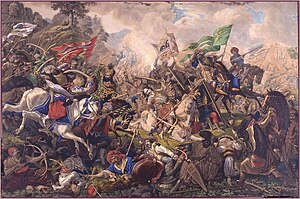Battle of Breadfield
This article needs additional citations for verification. (September 2016) |
| Battle of Breadfield | |||||||
|---|---|---|---|---|---|---|---|
| Part of the Ottoman–Hungarian Wars | |||||||
 Battle of Breadfield by Eduard Gurk | |||||||
| |||||||
| Belligerents | |||||||
| Ottoman Empire | |||||||
| Commanders and leaders | |||||||
|
Basarab Laiotă cel Bătrân | Ali Bey | ||||||
| Strength | |||||||
|
12-15,000 men ( Poles , Transylvanian Vlachs) | Around 30,000 men consisting of | ||||||
| Casualties and losses | |||||||
| 3,000 killed[citation needed] |
5,000-9,000 Ottomans killed 1,000 Wallachian[citation needed] | ||||||
The Battle of Breadfield (
The result of the battle was an important victory for the Kingdom of Hungary and the Serbian Despotate.
Background
From his ascendence to the Hungarian throne in 1458, King Matthias fought with the Turks, and in 1463, he occupied the northern parts of Bosnia. However, this was not a full-scale war.
Turkish marauders attacked Transylvania and Vojvodina several times between 1474 and 1475. The attacks led to the depopulation of some areas with a number of villages abandoned by their inhabitants.
After the
The Ottoman army entered Transylvania on October 9, near
The Turks continued pillaging and taking prisoners, while Báthory and Kinizsi made preparations to set forth against the Turks.
Hungarian and Ottoman armies
The numerical strength of the Ottoman army is under debate; one estimate judged them to be 60,000, while Hungarian sources placed them closer to 30,000.
Kinizsi's army consisted of
Battle
On October 9 the Turkish army entered Hungary and began raiding. Báthory waited until the Turks got exhausted in marching and raiding, and once the Ottomans had collected too much loot to move fast enough, he attacked them on October 13.
Both armies were composed of three columns. The right flank of the Hungarian army was led by Kinizsi, the left was the Serbian light cavalry under

The battle commenced in the afternoon. Báthory fell from his horse and the Ottomans nearly captured him, but a nobleman called Antal Nagy whisked the voivode away. Having joined battle, the Ottomans were in ascendancy early on, but Kinizsi charged against the Turks with the Hungarian heavy cavalry and 900 Serbs under Jakšić assisted by "numerous courtiers of the king".
Aftermath
Ottoman casualties were extremely high with several thousand men killed, among them
In 1480 Kinizsi raided Serbia and several times defeated Ali Koca Bey. The battle of Breadfield was a great psychological victory for the Hungarians, and as a result the Ottoman Turks did not attack southern Hungary and Transylvania for many years thereafter.
See also
References
- ^ a b Battle of Breadfield (1479), 'Conflict and Conquest in the Islamic World: A Historical Encyclopedia, Vol. 1, ed. Alexander Mikaberidze, (ABC-CLIO, 2011), 215.
- ^ Kármán & Kunčevic 2013, p. 266.
Bibliography
- Kármán, Gábor; Kunčevic, Lovro, eds. (2013). The European Tributary States of the Ottoman Empire in the Sixteenth and Seventeenth Centuries. Leiden: Brill. ISBN 9789004246065.
- Lengyel, Dénes (1972). Régi Magyar mondák. Budapest: Móra Ferenc. ISBN 963-11-2928-4.
- Csorba, Csaba; János Estók; Konrád Salamon (1998). Magyarország Képes Története. Budapest: Hungarian Book-Club. ISBN 963-548-961-7.
- Babinger, Franz (1978). Mehmed the Conqueror and his time. Princeton University Press. ISBN 0-691-01078-1.
External links
- Ferenc Szakály Ferenc and Pál Fodor: The Battle of Breadfiled, October 13 1479. Military notice, 111. class (1998.) 2.numb. (in Hungarian)
- Battle of Breadfield, October 13 1479. Archived 2004-12-12 at the Wayback Machine (in Hungarian)
